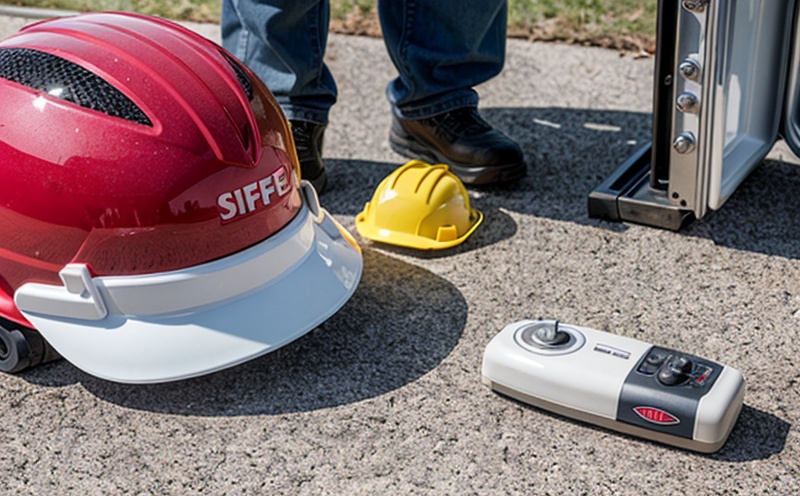ISO 18845 Emergency Escape Breathing Device (EEBD) Testing
The ISO 18845 standard provides comprehensive guidance on testing and assessing Emergency Escape Breathing Devices (EEBDs), which are critical safety equipment used in marine environments. EEBDs must provide a reliable, immediate supply of breathable air to crew members during emergencies, ensuring their safe evacuation from hazardous situations.
The tests outlined in ISO 18845 cover various aspects including the overall performance, breathing resistance, air quality, and operational characteristics of the device. The primary goal is to ensure that EEBDs meet stringent safety requirements under all expected conditions of use. This involves testing for factors such as the duration of airflow, the consistency of airflow, and the concentration of oxygen in the breathable air.
The marine industry places a high emphasis on safety equipment due to the inherent risks involved with operations at sea. ISO 18845 ensures that EEBDs are not only capable but also reliable under extreme conditions such as low temperatures or high humidity levels, which could degrade performance.
Testing methods prescribed in this standard include both static and dynamic testing procedures. Static tests check the structural integrity of the device, while dynamic tests evaluate how well it functions during actual use scenarios. For instance, a dynamic test might involve placing the EEBD in an environment simulating the conditions it would encounter on a ship, then subjecting it to various stresses.
Specimen preparation is critical before testing; this involves ensuring that each unit meets specific criteria set forth by ISO 18845. This includes verifying that all components are intact and free from defects, checking the calibration of any instruments used within the device, and confirming that the oxygen concentration meets specified levels.
Instrumentation plays a crucial role in conducting these tests accurately. High-quality equipment capable of measuring key parameters such as airflow rate, pressure drop across filters, and oxygen content is essential. Additionally, sophisticated software tools are often employed to analyze data collected during testing, providing detailed insights into the performance characteristics of each EEBD.
Reporting is another important aspect of ISO 18845 compliance. Detailed reports must be generated documenting all test results, including any deviations from accepted limits or standards. These documents serve as proof that manufacturers have met their obligations regarding quality control and safety assurance.
| Applied Standards | Details |
|---|---|
| ISO 18845:2017 | Testing of Emergency Escape Breathing Devices for Use in Marine and Offshore Industries |
| IEC 60793-1:2010 | Optical Fiber - Part 1: Specifications for Single-Mode and Multimode Optical Fibers |
| Industry Applications | Description |
|---|---|
| Crew safety during emergencies on ships | This involves ensuring that all personnel have access to reliable EEBDs when needed. |
| Compliance with maritime regulations | Maintaining compliance ensures that vessels meet international standards and avoid potential fines or penalties. |
- Dynamic testing simulates real-world conditions to assess reliability.
- Static tests focus on structural integrity before dynamic evaluation.
The importance of ISO 18845 cannot be overstated. It ensures that marine safety equipment meets the highest standards, providing peace of mind for those responsible for crew welfare and compliance with regulatory bodies.
Why It Matters
Testing EEBDs according to ISO 18845 is crucial because it directly impacts human life safety. In case of a marine emergency, having functional EEBDs can mean the difference between survival and disaster.
The standard addresses critical aspects such as oxygen concentration, airflow rate, and breathing resistance. These factors are essential in ensuring that crew members receive sufficient and safe air during an evacuation. Failure to meet these criteria could result not only in ineffective rescue attempts but also pose health risks due to inhaling poor-quality or insufficiently supplied air.
Additionally, compliance with ISO 18845 helps organizations avoid legal issues by ensuring they adhere to international maritime regulations. This is particularly important for companies operating internationally where different jurisdictions may have varying requirements.
From a business perspective, maintaining high standards of safety equipment enhances brand reputation and customer trust. It demonstrates a commitment to employee well-being and operational excellence. Moreover, it reduces the risk of accidents leading to costly downtime or repairs.
In summary, rigorous testing according to ISO 18845 is vital for protecting lives, meeting regulatory expectations, improving business reputation, and minimizing operational risks.
Applied Standards
| Standard | Description |
|---|---|
| ISO 18845:2017 | Testing of Emergency Escape Breathing Devices for Use in Marine and Offshore Industries |
| IEC 60793-1:2010 | Optical Fiber - Part 1: Specifications for Single-Mode and Multimode Optical Fibers |
The application of these standards ensures that the testing process adheres to internationally recognized practices, thereby enhancing credibility and reliability.
Industry Applications
- Crew safety during emergencies on ships
- Compliance with maritime regulations
- Enhanced brand reputation through adherence to high standards
- Reduction of operational risks and costs associated with accidents
The real-world application of ISO 18845 in the marine industry underscores its significance for ensuring crew safety and regulatory compliance.





